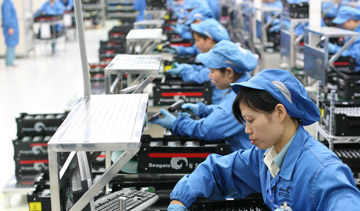 BEIJING — Chinas export growth slowed in December while imports accelerated, possibly helping to temper fears of a slowdown in the worlds second-largest economy.
BEIJING — Chinas export growth slowed in December while imports accelerated, possibly helping to temper fears of a slowdown in the worlds second-largest economy.
Exports rose 4.3 per cent to $207.7 billion, slowing from Novembers 12.7 per cent expansion, trade data showed Friday. imports rose 8.3 per cent to $182.1 billion, up from the previous months 7.6 per cent.
Stronger exports might be a sign Chinas domestic demand is relatively strong despite concerns a modest economic recovery is weakening.
Chinas economic growth tumbled to a two-decade low of 7.5 per cent in the second quarter. It rebounded to 7.8 per cent the following quarter but private sector analysts say that recovery is likely to fade. The Cabinet in late December said it expected 2013s full-year growth to be 7.6 per cent, which would be the weakest performance since 1999.
Our countrys economic development was stable overall, said a government spokesman, Zheng Yuesheng, at a news conference. However, he added, Chinas foreign trade enterprises face a complex and fickle domestic and international environment.
For the full year, exports were $2.2 trillion while imports were $1.9 trillion. Chinas global trade surplus widened by 12.6 per cent to $260.2 billion.
Zheng said it was the first time Chinas total annual trade topped $4 trillion. China edged past the United States in 2012 as the worlds biggest trader and likely widened its lead last year.
Analysts said December trade might be stronger than it appeared in comparison with figures a year earlier, when analysts believe exporters reported falsely inflated prices to evade currency controls and bring money into China for investment. Citigroup said real growth might be 9 per cent, more than double the reported level.
RELATED: Exports, imports down in October, trade surplus hits $75M StatsCan
The pickup in export momentum in recent months is real, said RBS economist Louis Kuijs in a report.
As for imports, growth was very strong and beat market expectations, said Goldman Sachs economists in a report.
China has long been the worlds factory, with a voracious appetite for oil, iron ore and other raw materials that propelled economic booms in Brazil, Australia and other commodities exporters. More recently, it is emerging as a major market, helping to drive demand for food, mobile phones, autos and other consumer goods.
Communist leaders are trying to reduce reliance on trade and investment by promoting domestic consumption but household spending is rising more slowly than they want. That forced Beijing to backtrack temporarily last year and launch a mini-stimulus to shore up growth with higher spending on building railways and other public works.
Export-driven manufacturing still employs millions of workers and any weakness raises the risk of job losses and unrest. Surveys earlier showed manufacturing activity weakened in December.
In a reflection of Chinas stronger growth and demand for imports, its politically sensitive trade surpluses with the United States and the European unio narrowed for both December and the full year of 2013, though the gaps still were large.
The surplus with the United States in December narrowed by 4.8 per cent to $17.8 billion and for the full year by 1.3 per cent to $215.9 billion. That with the 27-nation EU narrowed by 1.5 per cent in December to $12.9 billion and for 2013 by 2.5 per cent to $118.9 billion.
Zheng, the government spokesman, expressed confidence 2014 would be a period of steady growth for trade, though he gave no details.




